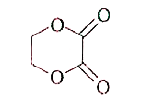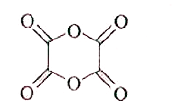Ethylene glycol when heated in the presence of anhydrous ZnCl2 yields
vinyl alcohol
ethyl alcohol
acetadehye
acetic acid
The correct Answer is:C
To solve the question regarding the product formed when ethylene glycol is heated in the presence of anhydrous ZnCl₂, we can follow these steps:
1. Identify the Reactants:
- The reactant is ethylene glycol, which has the chemical formula C2H6O2 or CH2OH-CH2OH.
2. Understand the Role of Anhydrous ZnCl₂:
- Anhydrous zinc chloride (ZnCl2) acts as a dehydrating agent. This means it will facilitate the removal of water (H₂O) from the ethylene glycol.
3. Dehydration Reaction:
- When ethylene glycol is heated with anhydrous ZnCl₂, a dehydration reaction occurs. The hydroxyl (–OH) group from one carbon and a hydrogen (–H) from the adjacent carbon are removed, resulting in the formation of a double bond between the two carbon atoms.
- The reaction can be represented as:
CH2OH-CH2OHZnCl2−−−→CH2=CHOH+H2O
- This results in the formation of vinyl alcohol (enol form).
4. Tautomerization:
- Vinyl alcohol (enol) is not very stable and undergoes tautomerization to form acetaldehyde (keto form). The tautomerization can be represented as:
CH2=CHOH⇌CH3CHO
- Thus, the final product is acetaldehyde.
5. Conclusion:
- The product formed when ethylene glycol is heated in the presence of anhydrous ZnCl₂ is acetaldehyde.
Final Answer:
The correct answer is acetaldehyde.
---
- The reactant is ethylene glycol, which has the chemical formula C2H6O2 or CH2OH-CH2OH.
- Anhydrous zinc chloride (ZnCl2) acts as a dehydrating agent. This means it will facilitate the removal of water (H₂O) from the ethylene glycol.
- When ethylene glycol is heated with anhydrous ZnCl₂, a dehydration reaction occurs. The hydroxyl (–OH) group from one carbon and a hydrogen (–H) from the adjacent carbon are removed, resulting in the formation of a double bond between the two carbon atoms.
- The reaction can be represented as:
CH2OH-CH2OHZnCl2−−−→CH2=CHOH+H2O
- This results in the formation of vinyl alcohol (enol form).
- Vinyl alcohol (enol) is not very stable and undergoes tautomerization to form acetaldehyde (keto form). The tautomerization can be represented as:
CH2=CHOH⇌CH3CHO
- Thus, the final product is acetaldehyde.
- The product formed when ethylene glycol is heated in the presence of anhydrous ZnCl₂ is acetaldehyde.
The correct answer is acetaldehyde.
Similar Questions
Knowledge Check
When ethylene glycol is heated with oxalic acid in the presence of conc. H2SO4, the product formed is :
A B
B C
C D
D
Ansisole on reaction ith chloromethane in presence of anhydrous AlCl3 gives
Aa-methyl anisole and p-methoxy anisoleBp-methyl anisole and p -methoxy anisoleCa-methyl anisole and p-methyl anisoleDa-methoxy acetophenone and p-methoxy acetophenoneThe reaction of ethylene with Br2 in water in the presence of NaCl gives :
A1, 2-dibromoethaneB2-bromoethanolC1-bromo-2-chloroethaneDall of these
When benzene is heated with acetic anhydride in presence of anhydrous AlCl3, is product formed is-
View SolutionBenzldehyde condenses with N, N-dimethylaniline in presence of anhydrous ZnCl2 to give
View SolutionReaction of benzene with isobutylchloride (CH3CH(CH3)CH2Cl) in the presence of anhydrous AlCl3 yields.
View SolutionWhat happens when benzene is treated with acetyl chloride in the presence of anhydrous AlCl3
View SolutionEthylene oxide when treated with Grignard reagent yields
View Solution
